With watering restrictions in effect in much of the western United States, drought-tolerant landscaping is the new norm. Elsewhere, it’s still a good idea, as water is a precious resource to be conserved even where it is abundant. There is a lovely arid look that gardeners have come to associate with drought-tolerant plantings, but it’s also possible to achieve a lush look without much irrigation. It’s just a matter of choosing the right plants and designing the landscape to make the best use of available moisture.
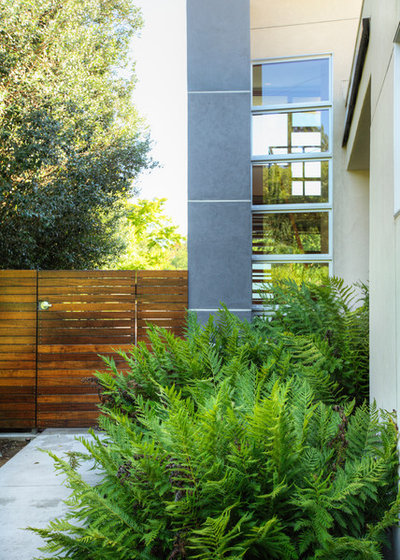
Dave Adams Photography
Look to arid landscapes for inspiration. Gardeners normally think of ferns as moisture-loving plants, but there are many species that can be found in dry habitats.
Western sword fern (
Polystichum munitum,
USDA zones 3 to 10; find your zone), shown here, grows in the forests of the West Coast, where rainfall is virtually nonexistent for six months of the year. It stays deep green nonetheless, pushing out fresh new fronds each spring after the winter rains. Its East Coast equivalent, Christmas fern (
Polystichum acrostichoides,
zones 3 to 8), is also quite drought tolerant.
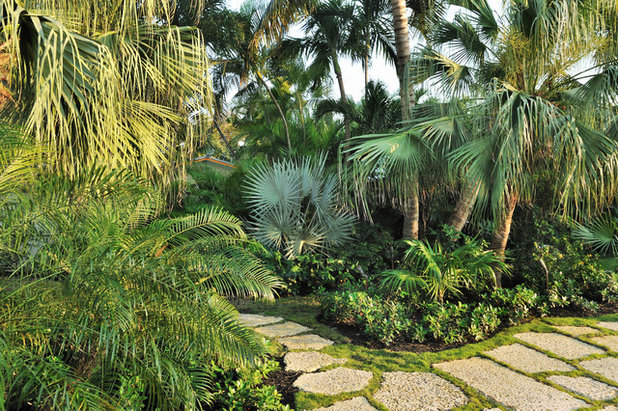
Craig Reynolds Landscape Architecture
Palm trees are another group of plants that create a lush, tropical vibe, yet there are many species with very low water needs. Any of the dozens of palms that are native to desert areas are a natural choice. Most fan palms —a generic name for species with broad fan-like leaves — tend to be drought tolerant. Fan palms are also among the cold hardiest palms. Here are a few with excellent drought tolerance:
- California fan palm (Washingtonia filifera, zones 8 to 11)
- Mediterranean fan palm (Chamaerops humilis, zones 8 to 11)
- Chinese windmill palm (Trachycarpus fortunei, zones 8 to 11)
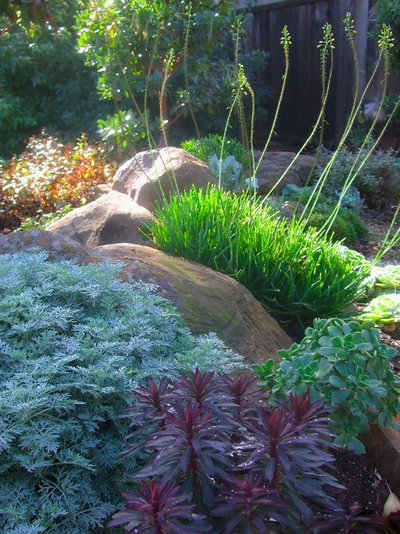
Edger Landscape Design
Mediterranean plants are generally a good bet for drought tolerance. On their own they create an arid look, but some have an incredibly lush feel and can easily be slipped into other planting schemes. Blue-gray foliage is one of nature’s signs of a plant with low water needs, and those plants can be employed to create a cool, soothing tone in the landscape.
Powis Castle artemisia (
Artemisia ‘Powis Castle’, zones 6 to 8), pictured here, is one of those plants. Its lacy leaves have the texture of silk and emit a heady aroma when you brush up against them.
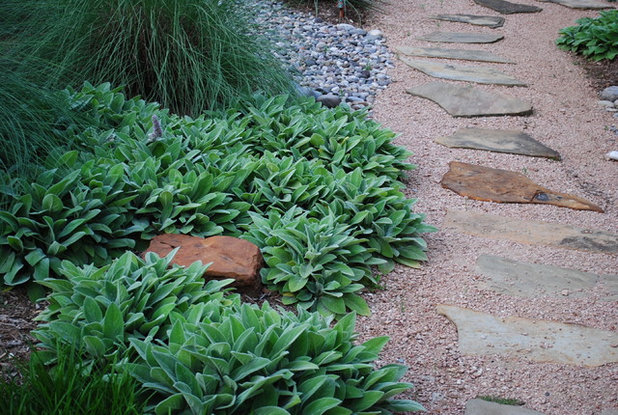
Jason Lackey, Landscape Designer
Another sign of drought tolerance in the plant kingdom is hairy leaves. Lamb’s ears (
Stachys byzantina,
zones 4 to 9) is a classic example. A low-growing, spreading plant, it makes a lush carpet with virtually no irrigation required. Use it as a ground cover, a filler or edging.
More ways to spot a drought-tolerant plant
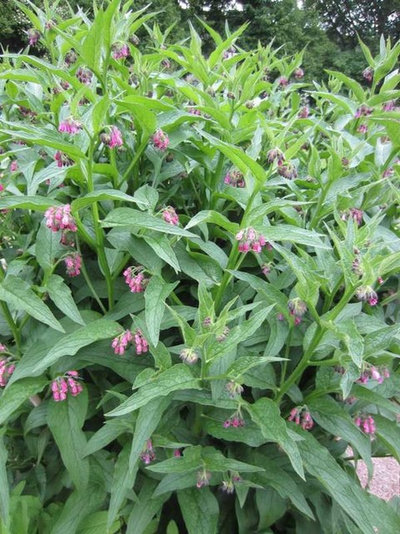
Missouri Botanical Garden
Plants with rhizomes, corms and tubers are well adapted to drought. Cactuses and succulents store water in their leaves, but many other species are adapted for storing water underground. Many bulbs burst from the ground in early spring when it is cool and moist, and then go dormant for the rest of the year. Others, such as the comfrey plant (
Symphytum officinale,
zones 4 to 8), shown here, have thick, fleshy roots that penetrate deep into the subsoil and provide moisture to the leaves during dry periods. Comfrey has some of the largest, lushest leaves for a plant of its size — when it’s grown in the shade, the leaves can reach 2 feet in length.
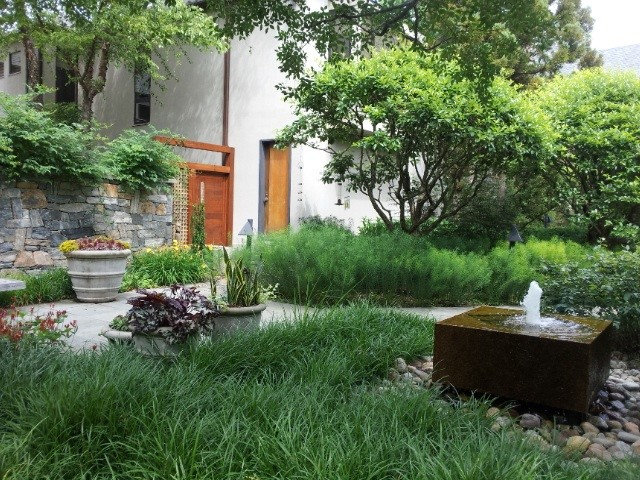
Design Farm Group
There are few plants that possess such a deep shade of green as monkey grass (
Liriope spp), shown here. Astoundingly, it stays that lush with little to no irrigation (especially when planted in the shade). It’s not a grass at all, but a tuberous plant in the asparagus family, with dainty purple or white flowers in spring.
L. spicata can be highly invasive in some areas, but
L. muscari is a well-behaved clumping plant that can be used without fear of its escaping into the wild. It is hardy to zones 6 to 9.
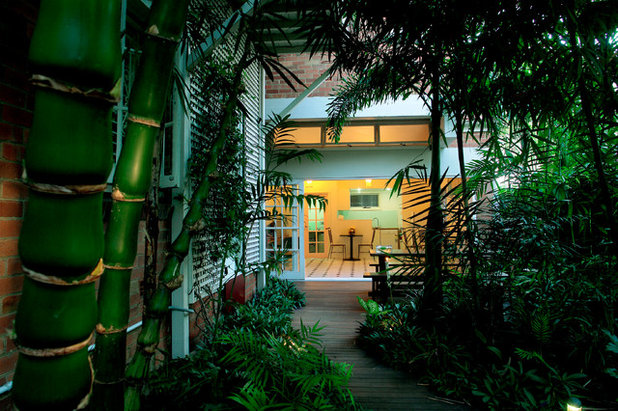
Lencom Pty Ltd
Along with palms, bamboo is another large group of plants associated with lush, tropical landscapes that actually includes many drought-tolerant species. This is largely a result of their rhizomatous growth habit — bamboo has underground stems that store water for times of low rainfall. The most drought-tolerant species are those with a clumping habit, as opposed to the running varieties that give bamboo a bad reputation as an invasive plant. Clumping varieties have deeper root systems.
Shown here are the bulbous canes of Buddha’s belly bamboo (
Bambusa tuldoides ‘Ventricosa’, zone 9), one of the most drought-tolerant species available. It eventually grows to a height of 50 feet with 2-inch-diameter canes.
See how to grow bamboo, even if you don’t have a lot of space
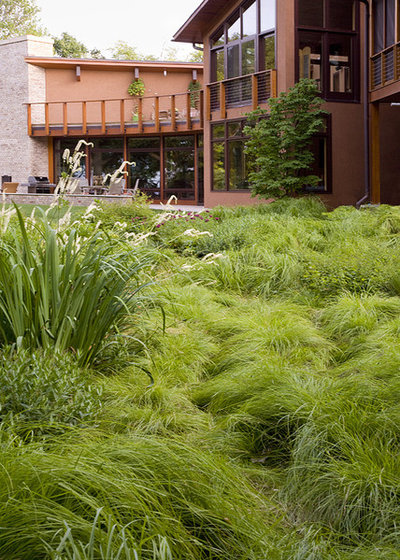
The Garden Consultants, Inc.
Design your landscape as a sponge. There are many ways to make the most of every drop of rain that falls. Note how the downspout in the top-right corner of this photo routes water directly to a planting of Sprengel’s sedge (
Carex sprengelii, zones 3 to 5) and rushes. These plants grow naturally at the edge of wetlands and are accustomed to oscillating between wet and dry conditions. Their lush foliage obscures the swale they are planted on.
Rain gardens are based on a similar principle of grading the earth into a basin that collects rainwater. The rainwater percolates into the soil, rather than running off and leaving the landscape dry and the roots thirsty.
Adding copious quantities of compost and other forms of organic matter to the soil prior to planting helps create a more sponge-like growing medium that holds water long after the last rainstorm. Also, remember that virtually all plants need irrigation for the first two years after planting — drought tolerance develops once the roots are well established. Finally, a thick layer of mulch around any planting slows the loss of soil moisture from evaporation and helps to keep things looking lush.





